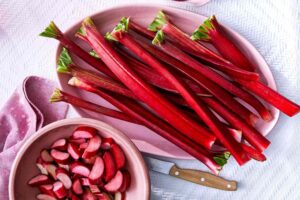Table of Contents
Rhubarb: A Vegetable in Disguise with Amazing Health Benefits
Rhubarb is a unique and often misunderstood plant, known for its vibrant color and tangy taste. While many people associate rhubarb with fruit-based desserts, such as the classic rhubarb pie, it’s actually a vegetable. However, in a legal twist, a 1947 court ruling classified it as a fruit, adding to the confusion. Regardless of its classification, rhubarb offers an array of health benefits, making it a wonderful addition to your diet.
What Is Rhubarb?
Rhubarb (Rheum rhabarbarum) is a perennial plant that thrives in cooler climates, particularly during spring. The plant is easily recognizable due to its brightly colored stalks, which range from deep pink to pale green. These stalks, along with the flowers, are the only edible parts of the plant, while its leaves contain toxic compounds and should never be consumed.

Rhubarb: Health Benefits, Risks, and How to Grow
The Nutritional Value of Rhubarb
Rhubarb is a low-calorie food, making it ideal for those seeking to maintain a healthy diet. Packed with essential vitamins and minerals, it offers significant health benefits despite its tangy taste. Key nutrients in a single cup of raw rhubarb (about 122 grams) include:
- Calories: 26
- Fiber: 2.2 grams
- Vitamin K: 35.7 micrograms (45% of the daily value)
- Vitamin C: 9.8 milligrams (16% of the daily value)
- Calcium: 105 milligrams (10% of the daily value)
- Potassium: 351 milligrams (10% of the daily value)
Besides these, rhubarb also contains antioxidants that help fight free radicals and support overall health.
Health Benefits of Rhubarb
1. Aids in Digestion
Rhubarb is a rich source of fiber, which plays a key role in promoting healthy digestion. Studies, such as one conducted at the Burn Treatment Center of Shanxi Province in China, have demonstrated rhubarb’s ability to improve digestive function by protecting the intestinal wall and aiding in the contraction of muscles within the gastrointestinal tract.
2. Strengthens Bones
One of the most significant benefits of rhubarb is its high vitamin K content. This vitamin is crucial for bone metabolism and helps prevent osteoporosis by aiding the carboxylation of osteocalcin, a protein essential for bone formation. Regular consumption of vitamin K-rich foods like rhubarb may improve bone density and reduce the risk of fractures. Learn more about the role of vitamin K in bone health.
3. Protects Against Brain Disorders
Rhubarb is packed with antioxidants, which can help prevent oxidative stress in the brain, a key contributor to cognitive decline. Research published in Molecular Medicine Reports found that rhubarb extract reduced inflammation in the brain, potentially lowering the risk of conditions such as Alzheimer’s and stroke.
4. Fights Free Radicals
The antioxidants in rhubarb, particularly quercetin, play a significant role in combating free radicals. This was evidenced by a study from the Northwest Institute of Plateau Biology, where rhubarb seeds were found to have a potent antioxidant effect. These antioxidants help protect the body from oxidative stress, reducing the risk of chronic diseases.
5. Relieves Constipation and Diarrhea
Rhubarb has natural laxative properties, making it an effective remedy for constipation. The plant has been used in traditional medicine to relieve gastrointestinal discomfort, whether in the form of extracts, powders, or as a dietary ingredient. However, it is essential to consult a healthcare provider before using rhubarb medicinally to avoid overconsumption.
6. Reduces Inflammation
Thanks to its anti-inflammatory properties, rhubarb has been used in Chinese medicine to treat various conditions. A study published in the Pakistan Journal of Pharmaceutical Sciences showed that rhubarb extract helped promote incision healing by reducing inflammation and preventing bacterial growth. Read more about rhubarb’s anti-inflammatory effects.
Risks and Side Effects
While rhubarb offers a range of health benefits, it’s essential to handle it with care due to its oxalic acid content. The plant’s leaves, in particular, contain high levels of oxalic acid and anthraquinone glycosides, both of which are toxic if ingested. Symptoms of poisoning can include difficulty breathing, nausea, and diarrhea. Fortunately, cooking the plant significantly reduces the oxalic acid content.
How to Grow Rhubarb
Rhubarb is a hardy plant that can be easily grown at home. It’s best planted in early spring or fall in fertile, well-drained soil. Space plants around four feet apart to ensure adequate growth. Be sure to water regularly, especially in the summer, and mulch with manure or straw to retain moisture.
Harvesting Rhubarb
Harvesting should not occur in the first year of growth to allow the plant to establish itself. Typically, rhubarb is ready for harvest in its second or third year, with the best time being from April to June. It’s crucial to pull or cut the stalks and immediately discard the toxic leaves. Regular harvesting strengthens the plant, promoting larger and more frequent yields in subsequent years.
How to Use Rhubarb
Rhubarb is highly versatile and can be used in various recipes. Its tart flavor pairs well with sweeter ingredients, such as strawberries, making it perfect for pies, crisps, and jams. However, there are other creative ways to enjoy rhubarb, from sauces to salads and even in savory dishes.
Delicious Rhubarb Recipes
- Strawberry Rhubarb Crisp
- Classic Strawberry Rhubarb Pie
- Rhubarb Chia Seed Pudding
Storing Rhubarb
To maximize the shelf life of rhubarb, store the stalks in a plastic bag in the refrigerator for up to five days. For longer-term storage, cut the stalks into small pieces and freeze them in an airtight container. Frozen rhubarb can be used in most recipes for up to a year.
Conclusion
Rhubarb may be a vegetable in disguise, but its vibrant color, tart flavor, and numerous health benefits make it a staple in many kitchens. Whether you’re growing it at home, using it in desserts, or benefiting from its digestive and bone-strengthening properties, rhubarb is a versatile and nutritious addition to any diet.